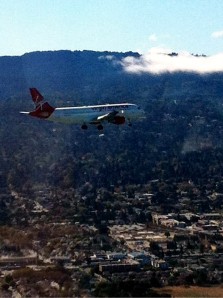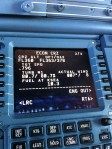Here’s how you land at San Francisco International. First, the view over your left shoulder as you cruise “downwind” for your arrival into San Francisco International. You’ve arrived from the Pacific side of the airport, so you can plan (they’ve probably advised you already) on landing on runway 28L, which is the runway you’re paralleling on downwind. Yes, there are 2 runways that you are paralleling, but the logical one for you is the one on the left. Here’s what the airport diagram looks like, with an arrow pointing to 28 Left:
Let’s talk about all of the runways at San Francisco International (SFO), because their are simultaneous operations on all four runways, so your landing runway is not operating independently or simply–nor are you as a pilot landing at SFO. Those two runways intersecting your landing runway will be launching aircraft out of SFO even as you are landing: yes, they’re crossing your runway–and you theirs–simultaneously. That means the SFO tower controllers are managing a complex ballet of speeds, timing and clearances. They’re doing a precise, excellent job, but a lot will depend on you: you must fly the assigned airspeed exactly in order for all of the moving parts in this synchronic mix of flying metal to mesh smoothly.
But wait, there’s more: runways 28 left and Right are too close together. Built built on a man-made pier, the pair are crammed closely together, closer than the standard, required spacing for parallel runways. Why does that matter? Well, because on final, aircraft approaching the runways at the same time will fly closer than the normal lateral separation required by the FAA standard:
Not taken with a telephoto lens. Rather, that’s a jet landing on 28L, taken from the cabin of one landing on 28R. Lateral separation is minimal–by virtue of a waiver of the standard separation that the FAA granted to SFO–so there are more restrictions on you, the pilot. First, you must not overtake the other aircraft. That’s because the trailing aircraft is charged with maintaining visual separation, because the leading aircraft can’t really see the trailing aircraft. If you overtake him, there will be a period where neither can maintain separation visually. So airspeed control must be exact, usually assigned by tower–to ensure separation from another part of the moving mechanism: aircraft are taking off on the intersecting runways, shooting the gap between your landing aircraft (and the parallel partner above) and the ones who landed before you.
Here’s the instrument approach for your landing runway–and there’s a complication today with that, too.
Today, the radio glidepath, or “Glideslope” (GS) is NOTAMed (NOTice to AirMen) out–meaning you will not have that descent guidance available on your display, so, you’ll be expected then to manually crosscheck the “step down” altitudes (7000, 6000, 5000, 4000, 3100, 1800, and 213) against the distance marked on this chart. All while flying the specified speed assigned by tower, which you must integrate with the maximum speeds allowed by the flap configuration required for the approach and landing.
Sounding too complicated to manage? Well, it’s not. In fact, it’s routine: very often, you’ll encounter intersecting runway operations (Chicago O’Hare comes to mind, and those controllers do a fantastic job of choreographing that ballet); many airports have reduced, FAA-waived runway separation (hello, Minneapolis), and at any given time, airports around the nation report various instrument landing system components temporarily out of service .
The glideslope being out wasn’t a surprise, either: you were advised by NOTAM (see above) before you even took off on this leg of the condition of the equipment and on your approach briefing (probably done within the last hour) you reviewed the requirements, procedures and complication with the other pilot(s) in the cockpit prior to starting the approach. And if you’re savvy, just in case, you briefed the approach to the parallel runway as well. That’s because at any point, due to traffic load or other factors, SFO tower can swap you to the other runway–just like that but again, that’s routine in the airline biz. Expect it, pre-brief it, deal with it.
Which means reprogramming the correct approach points in the Flight Management System (FMS) on the fly (pun intended) and verify each point, then set up the correct intercept to a forward waypoint in the FMS. All the while, don’t forget our friend out there–it’s your responsibility to stay clear–
Fly the speed assigned to the waypoint assigned, maintain the altitude minimums according to the above chart by comparison with your distance from the field and . . . configure for landing, while observing the flap speed limitations of your jet.
Here’s where you get to do your own balancing act within the swirling gearbox of approaches, landings, takeoffs and climbouts: if tower assigns you to fly a speed of 200 to “DUYET,” (see approach diagram above), that means you are limited to flaps 15 (have to be below 190 for more). But DUYET is at 1,800 feet and your airline has a “stabilized approach” policy below 1,000 feet: must be in final landing configuration and stabilized airspeed (neither increasing or decreasing) with a stable power setting (neither spooling up or down) from 1,000 feet to touchdown.
From 1,800 at DUYET to 1,000 feet, at a standard descent rate of around 800-900 feet per minute, you’ll have about 60 seconds, maybe less depending on tailwinds, to decelerate about 50 knots, then re-stablize the speed and power, and extend the flaps from 15 to 25 to 30 or 40 for landing. If not, mandatory go-around–meaning, initiate a climb following the “Missed Approach” instructions on the chart above. That’s also included in your approach briefing, remember which one–left or right–that you’re doing because remember, there are aircraft launching as well, mixing into the airspace. Then either repeat the approach (also very routine) or divert.
Stabilized? Good–now the only thing YOU must do is monitor descent rate, speed and alignment. That’s why a stabilized approach is vital: being set in descent rate and airspeed and power setting frees you to simply fly to a safe landing. After an approach that you now know is anything but simple. Happy landings.










No comments:
Post a Comment